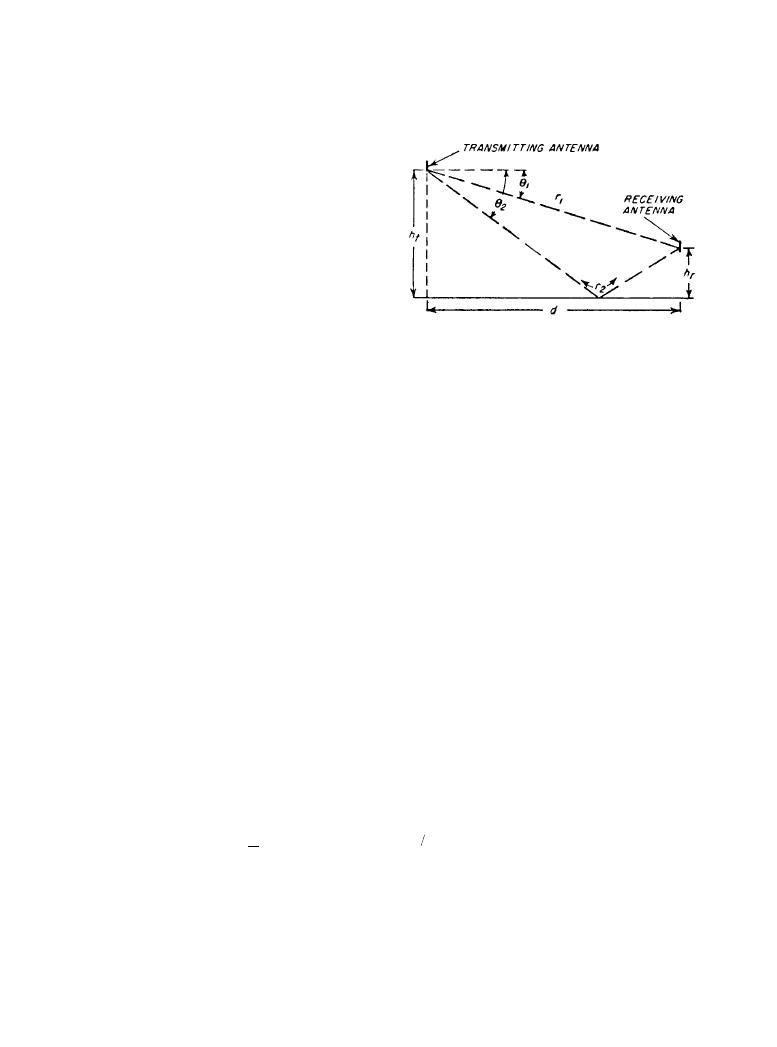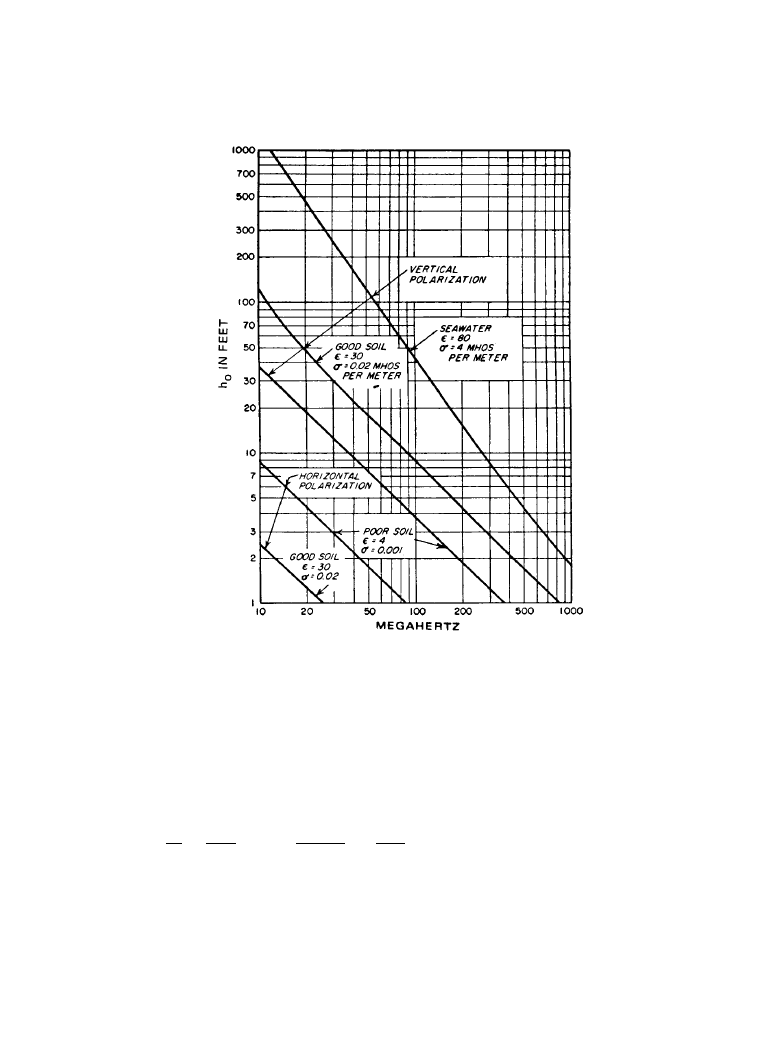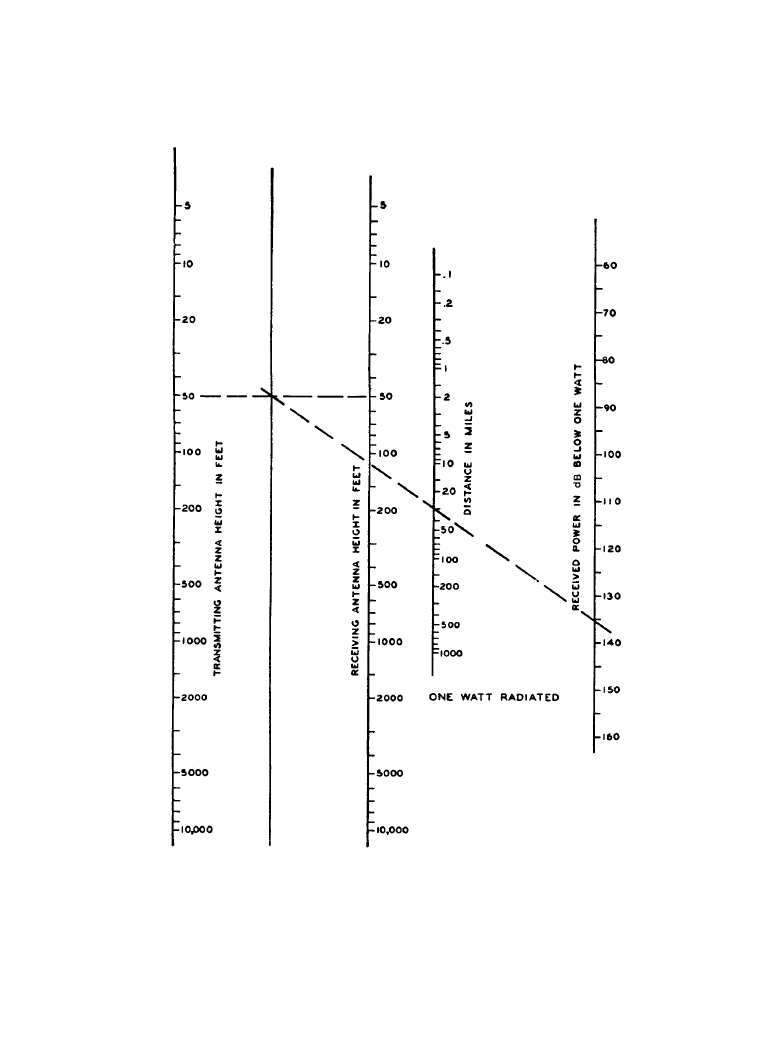ВУЗ: Казахская Национальная Академия Искусств им. Т. Жургенова
Категория: Книга
Дисциплина: Не указана
Добавлен: 03.02.2019
Просмотров: 21683
Скачиваний: 19

Propagation 11-27
(11.2.14)
When the angle
θ is very small, R is approximately equal to –1. For the case of two antennas,
one or both of which may be relatively close to the earth, a surface-wave term must be added and
Equation (11.2.14) becomes [3, 6]:
(11.2.15)
The quantity A is the surface-wave attenuation factor, which depends upon the frequency,
ground constants, and type of polarization. It is never greater than unity and decreases with
increasing distance and frequency, as indicated by the following approximate equation [1]:
(11.2.16)
This approximate expression is sufficiently accurate as long as A <0.1, and it gives the magni-
tude of A within about 2 dB for all values of A. However, as A approaches unity, the error in
phase approaches 180°. More accurate values are given by Norton [3] where, in his nomencla-
ture, A = f (P,B) e
i
φ
.
The equation (14.4.15) for the absolute value of field strength has been developed from the
successive consideration of the various components that make up the ground wave, but the fol-
lowing equivalent expressions may be found more convenient for rapid calculation:
(11.2.17)
When the distance d between antennas is greater than about five times the sum of the two
antenna heights h
t
and h
r
, the phase difference angle
∆ (rad) is:
(
)
1
j
o
E
E
R e
∆
=
+
E
E
o
1
Re
j
∆
1
R
–
(
)Ae
j
∆
+
+
[
]
=
A
1
–
1
j
2
πd
λ
---------
θ z )
2
+
sin
(
+
-------------------------------------------------------
≅
E
E
j
R
R A e
o
j
=
+
+
(
)+ −
(
)
2
2
1
1
2
sin
∆
∆
Figure 11.2.3
Ray paths for antennas
above plane earth. (
From [2]. Used with
permission.)
Downloaded from Digital Engineering Library @ McGraw-Hill (www.digitalengineeringlibrary.com)
Copyright © 2004 The McGraw-Hill Companies. All rights reserved.
Any use is subject to the Terms of Use as given at the website.
Propagation

11-28 Broadcast Transmission Systems
(11.2.18)
Also, when the angle
∆ is greater than about 0.5 rad, the terms inside the brackets of Equation
(11.2.17)—which include the surface wave—are usually negligible, and a sufficiently accurate
expression is given by the following:
(11.2.19)
In this case, the principal effect of the ground is to produce interference fringes or lobes, so that
the field strength oscillates about the free-space field as the distance between antennas or the
height of either antenna is varied.
When the angle
∆ is less than about 0.5 rad, there is a region in which the surface wave may
be important but not controlling. In this region, sin
∆/2 is approximately equal to ∆/2 and:
(11.2.20)
In this equation h
′ = h + jh
o
, where h is the actual antenna height and h
o
=
λ/2πz has been desig-
nated as the minimum effective antenna height. The magnitude of the minimum effective height
h
o
is shown in Figure 11.2.4 for seawater and for “good” and “poor” soil. “Good” soil corre-
sponds roughly to clay, loam, marsh, or swamp, while “poor” soil means rocky or sandy ground
[1].
The surface wave is controlling for antenna heights less than the minimum effective height,
and in this region the received field or power is not affected appreciably by changes in the
antenna height. For antenna heights that are greater than the minimum effective height, the
received field or power is increased approximately 6 dB every time the antenna height is dou-
bled, until free-space transmission is reached. It is ordinarily sufficiently accurate to assume that
h
′ is equal to the actual antenna height or the minimum effective antenna height, whichever is
the larger.
When translated into terms of antenna heights in feet, distance in miles, effective power in
kilowatts radiated from a half-wave dipole, and frequency F in megahertz, Equation (11.2.20)
becomes the following very useful formula for the rapid calculation of approximate values of
field strength for purposes of prediction or for comparison with measured values:
(11.2.21)
4
t
r
h h
d
π
λ
∆ =
E
E
h h
d
o
t r
=
2
2
sin
π
λ
4
t
r
o
h h
E
E
d
π
λ
′ ′
=
E
F
h h
P
d
t
r
t
≅
′ ′
3
2
Downloaded from Digital Engineering Library @ McGraw-Hill (www.digitalengineeringlibrary.com)
Copyright © 2004 The McGraw-Hill Companies. All rights reserved.
Any use is subject to the Terms of Use as given at the website.
Propagation

Propagation 11-29
11.2.3b
Transmission Loss Between Antennas Over Plane Earth
The ratio of the received power to the radiated power for transmission over plane earth is
obtained by substituting Equation (11.2.20) into (11.2.8), resulting in the following:
(11.2.22)
This relationship is independent of frequency, and is shown on Figure 11.2.5 for half-wave
dipoles (g
t
= g
r
= 1.64). A line through the two scales of antenna height determines a point on
P
P
d
g g
h h
d
h h
d
g g
r
t
t
r
t
r
t
r
t
r
=
′ ′
=
′ ′
λ
π
π
λ
4
4
2
2
2
Figure 11.2.4
Minimum effective antenna height. (
From [2]. Used with permission.)
Downloaded from Digital Engineering Library @ McGraw-Hill (www.digitalengineeringlibrary.com)
Copyright © 2004 The McGraw-Hill Companies. All rights reserved.
Any use is subject to the Terms of Use as given at the website.
Propagation

11-30 Broadcast Transmission Systems
the unlabeled scale between them, and a second line through this point and the distance scale
determines the received power for 1 W radiated. When the received field strength is desired, the
power indicated on Figure 11.2.5 can be transferred to scale 4 of Figure 11.2.1, and a line
through the frequency on scale 3 indicates the received field strength on scale 2. The results
shown on Figure 11.2.5 are valid as long as the value of received power indicated is lower than
that shown on Figure 11.2.3 for free-space transmission. When this condition is not met, it means
that the angle
∆ is too large for Equation (11.2.20) to be accurate and that the received field
strength or power oscillates around the free-space value as indicated by Equation (11.2.19) [1].
11.2.3c
Propagation Over Smooth Spherical Earth
The curvature of the earth has three effects on the propagation of radio waves at points within the
line of sight:
•
The reflection coefficient of the ground-reflected wave differs for the curved surface of the
earth from that for a plane surface. This effect is of little importance, however, under the cir-
cumstances normally encountered in practice.
•
Because the ground-reflected wave is reflected against the curved surface of the earth, its
energy diverges more than would be indicated by the inverse distance-squared law, and the
ground-reflected wave must be multiplied by a divergence factor D.
•
The heights of the transmitting and receiving antennas h
t
′ and h
r
′ , above the plane that is tan-
gent to the surface of the earth at the point of reflection of the ground-reflected wave, are less
than the antenna heights h
t
and h
r
above the surface of the earth, as shown in Figure 11.2.6.
Under these conditions, Equation (11.2.14), which applies to larger distances within the line of
sight and to antennas of sufficient height that the surface component may be neglected, becomes:
(11.2.23)
Similar substitutions of the values that correspond in Figures 11.2.3 and 11.2.6 can be made
in Equations (11.2.15 through (11.2.22). However, under practical conditions, it is generally sat-
isfactory to use the plane-earth formulas for the purpose of calculating smooth-earth values. An
exception to this is usually made in the preparation of standard reference curves, which are gen-
erally calculated by the use of the more exact formulas [1, 4–9]
11.2.3d
Propagation Beyond the Line of Sight
Radio waves are bent around the earth by the phenomenon of diffraction, with the ease of bend-
ing decreasing as the frequency increases. Diffraction is a fundamental property of wave motion,
and in optics it is the correction to apply to geometrical optics (ray theory) to obtain the more
accurate wave optics. In wave optics, each point on the wave front is considered to act as a radi-
ating source. When the wave front is coherent or undisturbed, the resultant is a progression of the
front in a direction perpendicular thereto, along a path that constitutes the ray. When the front is
disturbed, the resultant front can be changed in both magnitude and direction with resulting
(
)
1
j
o
E
E
D R e
∆
=
+
′
Downloaded from Digital Engineering Library @ McGraw-Hill (www.digitalengineeringlibrary.com)
Copyright © 2004 The McGraw-Hill Companies. All rights reserved.
Any use is subject to the Terms of Use as given at the website.
Propagation

Propagation 11-31
Figure 11.2.5
Received power over plane earth between half-wave dipoles.
Notes: (1) This chart
is not valid when the indicated received power is greater than the free space power shown in Fig-
ure 11.2.1. (2) Use the actual antenna height or the minimum effective height shown in Figure
11.2.4, whichever is the larger. (
From [2]. Used with permission.)
Downloaded from Digital Engineering Library @ McGraw-Hill (www.digitalengineeringlibrary.com)
Copyright © 2004 The McGraw-Hill Companies. All rights reserved.
Any use is subject to the Terms of Use as given at the website.
Propagation